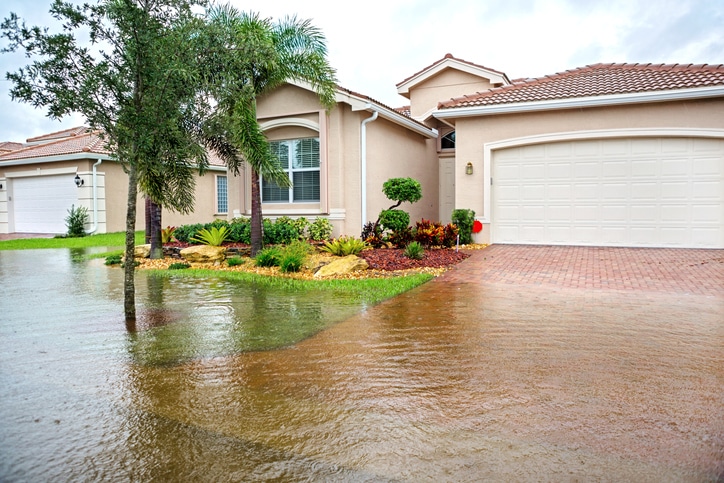Source: Sierra —
LIZ GREENE HADN’T ORIGINALLY intended to buy this house. She’d been looking at another one here in the River Haven subdivision, 20 miles northeast of Myrtle Beach, South Carolina. It had the same beige siding, the same slab foundation and still-growing-in yard, but it was in a location she liked better. At the last minute, though, the developer who built the subdivision slid her into this one.
Before she bought the house, Greene said, she asked the builder and the real estate agent if the property tended to flood. “They said, ‘Not a drop.'” Shortly after moving in, she began to get hints that this might not be true. A utility-company worker told Greene, “We wondered who’d get stuck with that lot.”
Soon she understood why. The house sits a good eight feet below the road behind it, and five or six feet lower than the other homes on the block. When it rains, water immediately gathers in the yard. “You get a drizzle, and if the ground is already saturated, it’ll be like a moat around the house,” Greene said. “I sit in water all the time.”
So far, the water hasn’t entered her house. But in 2018, two years before Greene bought the property, Hurricane Florence came through and badly flooded the area; her lot was underwater. She’s terrified it will happen again and inundate everything she owns.
In Horry County, flooding experiences like Greene’s are far from rare. The Facebook page of Horry County Rising, a local flood-focused group, is busy with thousands of followers. In between informational messages from the group’s founder, April O’Leary, residents write about their swamped kitchens or soaking yards. Such posts often earn dozens of sympathetic, “I’ve been there” comments.
“Prayers for everyone that is flooding. Our yard has flooded now for the eighth time. We have lost so much stuff,” one resident wrote. Another said, “I have lived here my whole life, and it has gotten far worse. Yes, these areas have always flooded, but never this often. This is insane.”
It’s true that recent hurricanes have been severe; Hurricane Florence led to more than 2,000 flooded homes in the county. The problem, though, isn’t simply storm surges along the coast. It’s the very nature of the low-lying landscape. Several rivers meander through the flat, swampy county and overflow after intense downpours, the kind that are occurring much more frequently as a warmer atmosphere leads to more intense rain events.
Rather than backing away from climate-risky areas, ordinary home buyers and real estate investors are pouring into them.
This is a deep-red county in a Republican state, and the term climate change rarely comes up. Instead, people attribute the water issues to destroyed marshlands and razed forests. “Places are flooding that have never flooded before due to filling wetlands and removing trees,” reads a common sentiment on the Horry County Rising Facebook page.
The increase in flooding in Horry County parallels another upsurge there: population growth. Over the past decade, the Myrtle Beach area has boomed, particularly during the coronavirus pandemic. Horry County gained almost 100,000 people between 2010 and 2021.
In response, real estate developers have been on a building tear. Lacking much resistance from a historically pro-development county council, housebuilders frequently fill wetlands—which compose almost 40 percent of the county—and reroute stormwater runoff. Sometimes it works. Other times, like in Greene’s case, the efforts to reshape the land result in flooded properties. Often, the houses aren’t in FEMA-designated flood zones, so their owners haven’t bought flood insurance.
Not all the Horry County homeowners who’ve experienced flooding are active on the Facebook page—nor are they always vocal in real life about their flooding woes. Some are silent, leaving open their option to repair the water damage and quietly sell their house to an unsuspecting newcomer. Not Greene. Though small and in her seventies, she’s dogged by nature; a sign in her house reads, “Underestimate me—that’ll be fun.” She started speaking out about her flooding issues in spring 2020. A dedicated member of Horry County Rising, she has complained to local reporters about the problems she’s been facing and has hung posters on her porch decrying the flooding.
Flood maps and footage show that Greene isn’t lying. Risk Factor—an online tool that homeowners can use to determine their property’s present and future climate threats—predicts that almost a third of properties in Horry County have more than a one-in-four risk of being severely affected by flooding over the next 30 years. Will there be a time when Horry County’s homeowners decide the good weather and beach access aren’t worth it, and walk away from their mortgages?
THERE ARE HUNDREDS OF Horry Counties around the United States. Well before COVID hit, many communities began filling with retiring baby boomers and remote workers in search of beautiful landscapes and a reasonable cost of living. Just about all of them are in regions with significant climate vulnerability.
Research from Redfin shows that between 2016 and 2020, the southeastern coast, Texas, Arizona, the interior of California, and the Mountain West all saw big population increases and skyrocketing home values. Those trends increased during the pandemic. At the same time, extreme weather events have been getting worse.
In Phoenix, the median home price surged by 69 percent between 2019 and 2022, according to Zillow, even as the Southwest was experiencing its deepest drought in 1,200 years. Shortly before it was battered by Hurricane Ian last fall, the southwest Florida town of Fort Myers was ranked as one of the fastest-growing cities in the nation. Across the West, some of the most popular communities are also the most fire-prone; in recent years, the acreage burned during a typical wildfire season has been double what it was in the 1990s.
Rather than backing away from climate-risky areas, ordinary home buyers and real estate investors are pouring into them—which is the exact opposite response from what climate change experts (or even common sense) would advise. The real estate frenzy has leveled off somewhat since interest rates began rising in mid-2022, but the overall trends are unlikely to change. The United States is experiencing a shortage of around 6 million housing units, and that will continue to drive demand, push prices up, and propel home buyers into climate-risk-prone areas that are affordable.
A basic problem will remain: The climate risks that are inherent in places like California’s Sierra Nevada foothills and coastal Florida are not being reflected in housing prices and insurance rates. Flaws in the market and largely invisible government subsidies are keeping costs artificially low and contributing to those regions’ attractiveness to buyers. In 2021, researchers found that houses in flood zones around the United States are overvalued by $44 billion; a year later, the actuarial firm Milliman put that number at $520 billion. The real figure is likely somewhere in between, but it’s undeniably huge—and neither of those studies included homes exposed to potential fire, heat, or drought.
Climate change’s impact on the housing market is in many ways an economics issue; it involves supply and demand, market signals, subsidies, and incentives. At its heart, however, this is a deeply human problem, one propelled less by giant, impersonal forces than by our individual efforts to create a good life for ourselves and to forge a connection to place and a sense of home.
Those powerful desires for belonging drive us—but only so far. When the possibility of disaster grows too great, or when weather-related nuisances become a regular thing, people eventually leave. Real estate experts say that if that were to occur at a large scale and many homeowners abandoned their mortgages, the United States could experience a housing crisis that rivals the 2008 market meltdown and lands squarely in the laps of US taxpayers, hurting low-income people in particular.
“There’s real uncertainty, but the number of mortgages in default could be as large as [in] the subprime crisis,” said Susan Wachter, a real estate and finance professor at the University of Pennsylvania’s Wharton School. It doesn’t have to happen, she insists. The probability of a climate-induced shock to the US real estate market is far enough off—a decade away, maybe more—that national policymakers and local planners and the public have time to adjust. “Now,” Wachter warned, “is the time to take steps to prevent harm and losses to taxpayers across the board.”
The US housing market is like a giant Jenga structure. One day we may find ourselves teetering at the top of a tall, wobbly edifice at risk of falling. The challenge of this moment is to figure out how to shore up the creaky structure—or dismantle it and inch our way down instead. Doing so will require foresight, political will, a consensus about protecting the vulnerable, an ability to make coordinated decisions, and a willingness to act in ways that might hurt the economy in the short term. For a society that managed to politicize a deadly disease, those qualities feel like a stretch right now. But a crisis that hits us where we live, literally, might have a way of sharpening Americans’ focus about climate chaos—and force us to act.
TO UNDERSTAND HOW THE climate crisis might tank the real estate market, the place to begin is at the most basic level: the individual. In order for a market to function efficiently and fairly, buyers and sellers need access to information so they can make reasonable choices. In many cases, however, homeowners don’t know their houses are in any danger. They might assume, falsely, that building isn’t allowed in risky areas.













So an article sourced by “a third party” with a by-line of Sienna with no last name – I am supposed to take seriously?
Get real.
Where was the lender who usually requires a flood certification?
Where was the title company who usually orders a property survey?
There is more than one player in the game,
With respect to her lot flooding, climate change/global warming/global cooling (pick your own scenario) will have a little, if anything to do with her lot flooding. I remember 35 years ago listening to Ted Danson on a beach in California say that if we didn’t do something about global warming within the next 10 years Manhattan would be underwater.. And every year since then, some very public person has proclaimed publicly that we’re going to flood in 10 years if we don’t do something.. And after telling me how to live my life, they go get on their private Learjet and fly off into the sunset.
What a load of…well, you know.
The house never should have been allowed to be built. Lax (or spineless) flood laws and over eager building practices, driven by buyers, are to blame. As an aside, many who push climate change are buying waterfront homes. Very curious.
Climate Change—enough already.